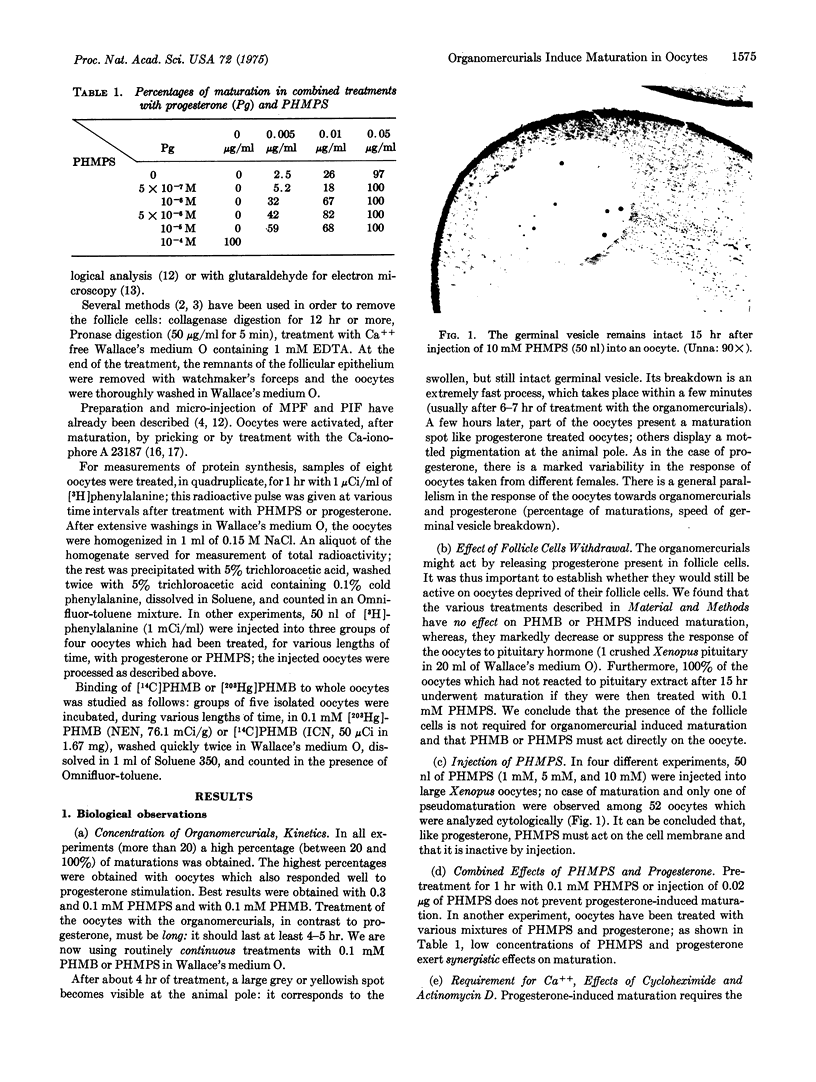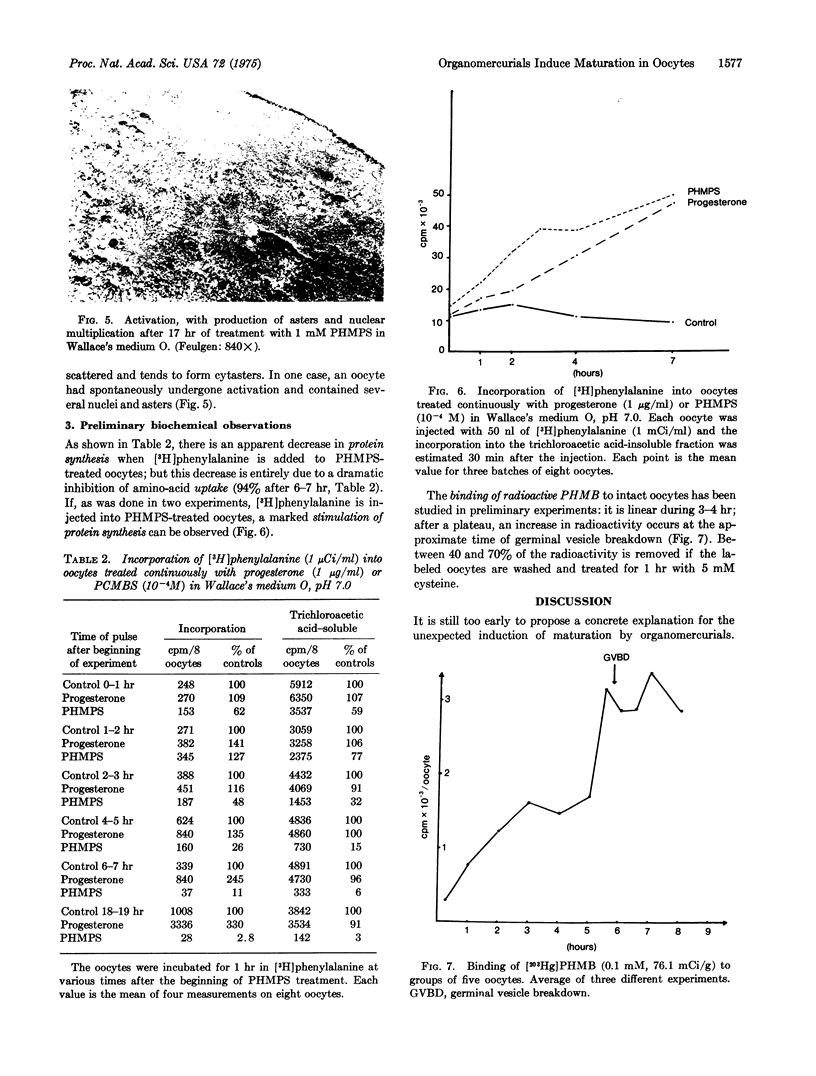Abstract
Three organomercurials, p-hydroxymercuribenzoate, p-hydroxymercuriphenylsulfonate, and mersalyl, induce maturation (meiosis) in a large percentage (20-100 percent) of Xenopus laevis oocytes. Maturation takes place even when the follicle cells which surround the oocytes have been withdrawn. Organomercurial- and progesterone-induced maturations have many features in common: they do not occur when the inducer is injected into the oocytes, they require the presence of Ca++ in the medium, they are inhibited by cycloheximide but not by actinomycin D. In both cases, the maturation producing factor and the pseudomaturation inducing factor are produced. Organomercurial-treated oocytes react normally to activating stimuli; their protein synthesis increases, but uptake of amino acids is strongly inhibited. Progesterone and p-hydroxymercuriphenyl-sulfonate act synergically in inducing maturation. The main difference between the two agents is that p-hydroxymercuriphenylsulfonate must act for several hours, whereas, short contact with progesterone is sufficient to induce maturation.
Full text
PDF




Images in this article
Selected References
These references are in PubMed. This may not be the complete list of references from this article.
- Brachet J., Baltus E., de Schutter A., Hanocq F., Hanocq-Quertier J., Hubert E., Iacobelli S., Steinert G. Biochemical changes during progesterone-induced maturation in Xenopus laevis oocytes. Mol Cell Biochem. 1974 May 30;3(3):189–205. doi: 10.1007/BF01686644. [DOI] [PubMed] [Google Scholar]
- Brachet J., Hanocq F., Van Gansen P. A cytochemical and ultrastructural analysis of in vitro maturation in amphibian oocytes. Dev Biol. 1970 Feb;21(1):157–195. doi: 10.1016/0012-1606(70)90067-9. [DOI] [PubMed] [Google Scholar]
- Hanocq F., De Schutter A., Hubert E., Brachet J. Cytochemical and biochemical studies on progesterone-induced maturation in amphibian oocytes. 2. DNA synthesis. Differentiation. 1974 Apr;2(2):75–90. doi: 10.1111/j.1432-0436.1974.tb00339.x. [DOI] [PubMed] [Google Scholar]
- Hellman B., Lernmark A., Sehlin J., Söderberg M., Täljedal I. B. The pancreatic -cell recognition of insulin secretagogues. VII. Binding and permeation of chloromercuribenzene-p-sulphonic acid in the plasma membrane of pancreatic -cells. Arch Biochem Biophys. 1973 Sep;158(1):435–441. doi: 10.1016/0003-9861(73)90640-1. [DOI] [PubMed] [Google Scholar]
- Jacobelli S., Hanocq J., Baltus E., Brachet J. Hormone-induced maturation of Xenopus laevis oocytes: effects of different steroids and study of the properties of a progesterone receptor. Differentiation. 1974 Jun;2(3):129–135. doi: 10.1111/j.1432-0436.1974.tb00346.x. [DOI] [PubMed] [Google Scholar]
- Kishimoto T., Kanatani H. Induction of starfish oocyte maturation by disulfide-reducing agents. Exp Cell Res. 1973 Dec;82(2):296–302. doi: 10.1016/0014-4827(73)90344-3. [DOI] [PubMed] [Google Scholar]
- Masui Y., Markert C. L. Cytoplasmic control of nuclear behavior during meiotic maturation of frog oocytes. J Exp Zool. 1971 Jun;177(2):129–145. doi: 10.1002/jez.1401770202. [DOI] [PubMed] [Google Scholar]
- Merriam R. W. Progesterone-induced maturational events in oocytes of Xenopus laevis. I. Continuous necessity for diffusible calcium and magnesium. Exp Cell Res. 1971 Sep;68(1):75–80. doi: 10.1016/0014-4827(71)90588-x. [DOI] [PubMed] [Google Scholar]
- Ozon R., Bellé R. Progesterone receptor associated with the "melanosome" fraction of Pleurodeles waltlii oocytes (Urodela amphibian). Biochim Biophys Acta. 1973 Oct 5;320(3):588–593. doi: 10.1016/0304-4165(73)90138-4. [DOI] [PubMed] [Google Scholar]
- Reynhout J. K., Smith L. D. Studies on the appearance and nature of a maturation-inducing factor in the cytoplasm of amphibian oocytes exposed to progesterone. Dev Biol. 1974 Jun;38(2):394–400. doi: 10.1016/0012-1606(74)90016-5. [DOI] [PubMed] [Google Scholar]
- Schorderet-Slatkine S. Action of progesterone and related steroids on oocyte maturation in Xenopus laevis. An in vitro study. Cell Differ. 1972 Aug;1(3):179–189. doi: 10.1016/0045-6039(72)90027-9. [DOI] [PubMed] [Google Scholar]
- Schorderet-Slatkine S., Drury K. C. Progesterone induced maturation in oocytes of Xenopus laevis. Appearance of a 'maturation promoting factor' in enucleated oocytes. Cell Differ. 1973 Oct;2(4):247–254. doi: 10.1016/0045-6039(73)90013-4. [DOI] [PubMed] [Google Scholar]
- Schuetz A. W. Role of hormones in oocyte maturation. Biol Reprod. 1974 Mar;10(2):150–178. doi: 10.1095/biolreprod10.2.150. [DOI] [PubMed] [Google Scholar]
- Smith L. D., Ecker R. E. Regulatory processes in the maturation and early cleavage of amphibian eggs. Curr Top Dev Biol. 1970;5:1–38. [PubMed] [Google Scholar]
- Smith L. D., Ecker R. E. The interaction of steroids with Rana pipiens Oocytes in the induction of maturation. Dev Biol. 1971 Jun;25(2):232–247. doi: 10.1016/0012-1606(71)90029-7. [DOI] [PubMed] [Google Scholar]
- Steinert G., Baltus E., Hanocq-Quertier J., Brachet J. Ultrastructure of Xenopus laevis oocytes after injection of an extract from progesterone-treated oocytes. J Ultrastruct Res. 1974 Nov;49(2):188–210. doi: 10.1016/s0022-5320(74)80031-6. [DOI] [PubMed] [Google Scholar]
- Steinhardt R. A., Epel D., Carroll E. J., Jr, Yanagimachi R. Is calcium ionophore a universal activator for unfertilised eggs? Nature. 1974 Nov 1;252(5478):41–43. doi: 10.1038/252041a0. [DOI] [PubMed] [Google Scholar]
- Wallace R. A., Jared D. W., Dumont J. N., Sega M. W. Protein incorporation by isolated amphibian oocytes. 3. Optimum incubation conditions. J Exp Zool. 1973 Jun;184(3):321–333. doi: 10.1002/jez.1401840305. [DOI] [PubMed] [Google Scholar]







